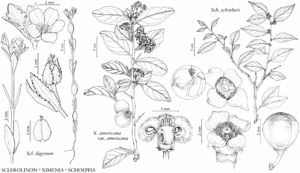Schoepfiaceae
Shrubs or trees [perennial herbs], root parasites, evergreen, synoecious; glabrous [hairy]. Leaves alternate [2 in fascicle], simple; stipules absent; petiole present; blade margins entire; venation pinnate. Inflorescences axillary [terminal], cymes [thyrses, spikes, umbels] or flowers solitary. Flowers bisexual, heterostylous; perianth and androecium epigynous; epicalyx present; hypanthium completely adnate to ovary; sepals unknown number [0], connate into cuplike rim; petals [3–]4–5[–6], connate, post-staminal hairs present [absent]; nectary present; stamens [3–]4–5[–6], opposite petals, distinct, adnate to corolla tube; anthers dehiscing by longitudinal slits; pistil 1, 2–3-carpellate, ovary inferior, 2–3-locular proximally, 1-locular distally, placentation free-central, ovules 3 per ovary, anatropous; style 1; stigma 1. Fruits drupes [nutlike achenes]. Seeds 1 per fruit.
Distribution
Fla., Mexico, West Indies, Central America, South America, Asia.
Discussion
Genera 3, species 50 (1 in the flora).
Although Schoepfia is often classified in Olacaceae, its placement has been dubious for over two centuries. Early molecular phylogenetic studies showed that this genus is more closely related to Loranthaceae and Misodendraceae than to Olacaceae (D. L. Nickrent and V. Malécot 2001). Later work (J. P. Der and Nickrent 2008) confirmed this result and also showed the association with Arjona Commerson ex Cavanilles and Quinchamalium Molina from Andean South America, in agreement with P. van Tieghem (1896). The cupular bracts (epicalyx) subtending the flowers may be a synapomorphy between Schoepfia and Quinchamalium. These three genera form the Schoepfiaceae in the classification of Santalales by Nickrent et al. (2010).
The homology of the reduced calyx in Schoepfiaceae and other Santalales, which often is referred to as a calyculus, has been controversial. D. L. Nickrent et al. (2010) and J. Kuijt (2013) argued that this structure is sepalar in origin, and that interpretation is followed here. The corolla in Schoepfiaceae and many other Santalales bears post-staminal hairs, which arise as a tuft opposite each anther and become attached to the anther by secretions.
Selected References
None.
